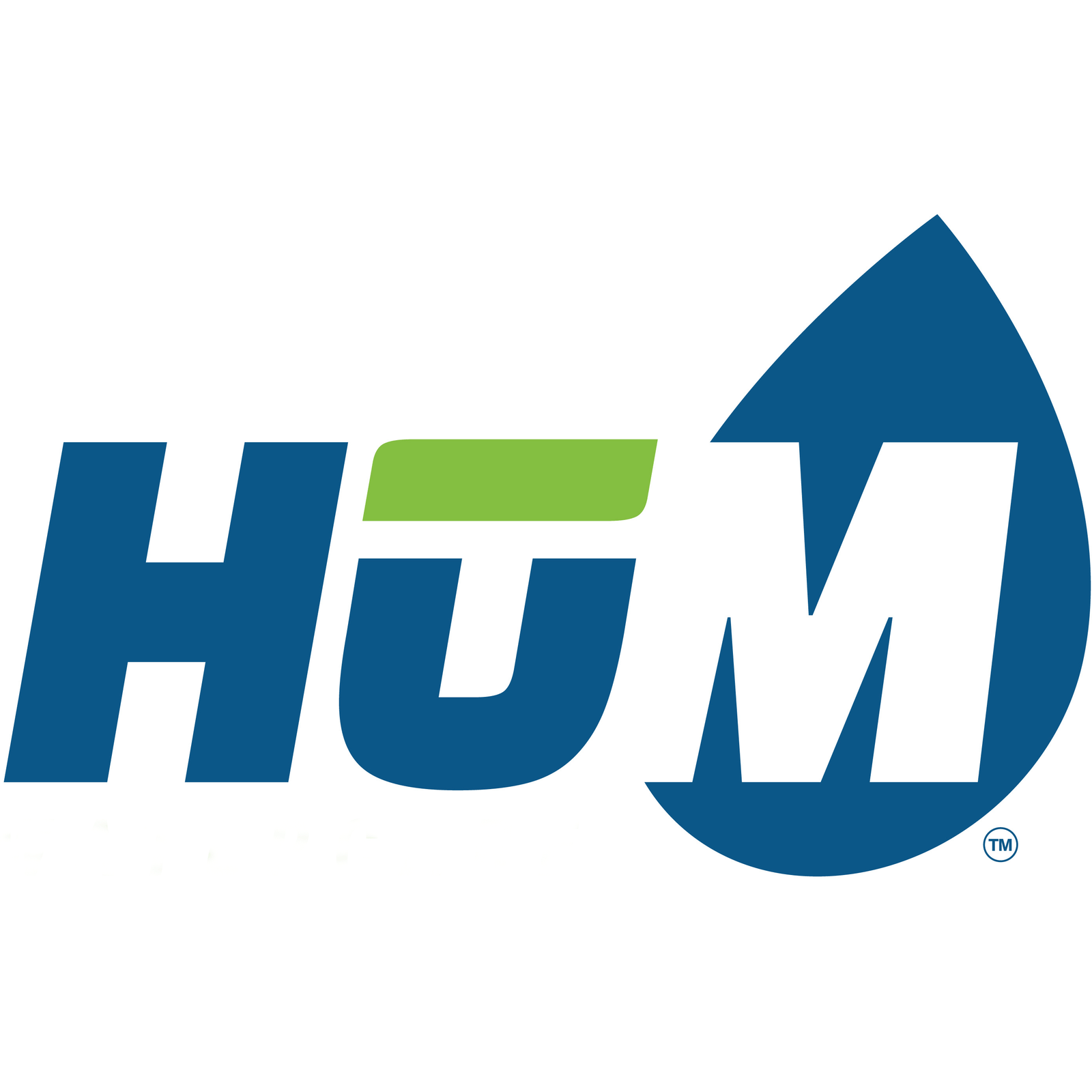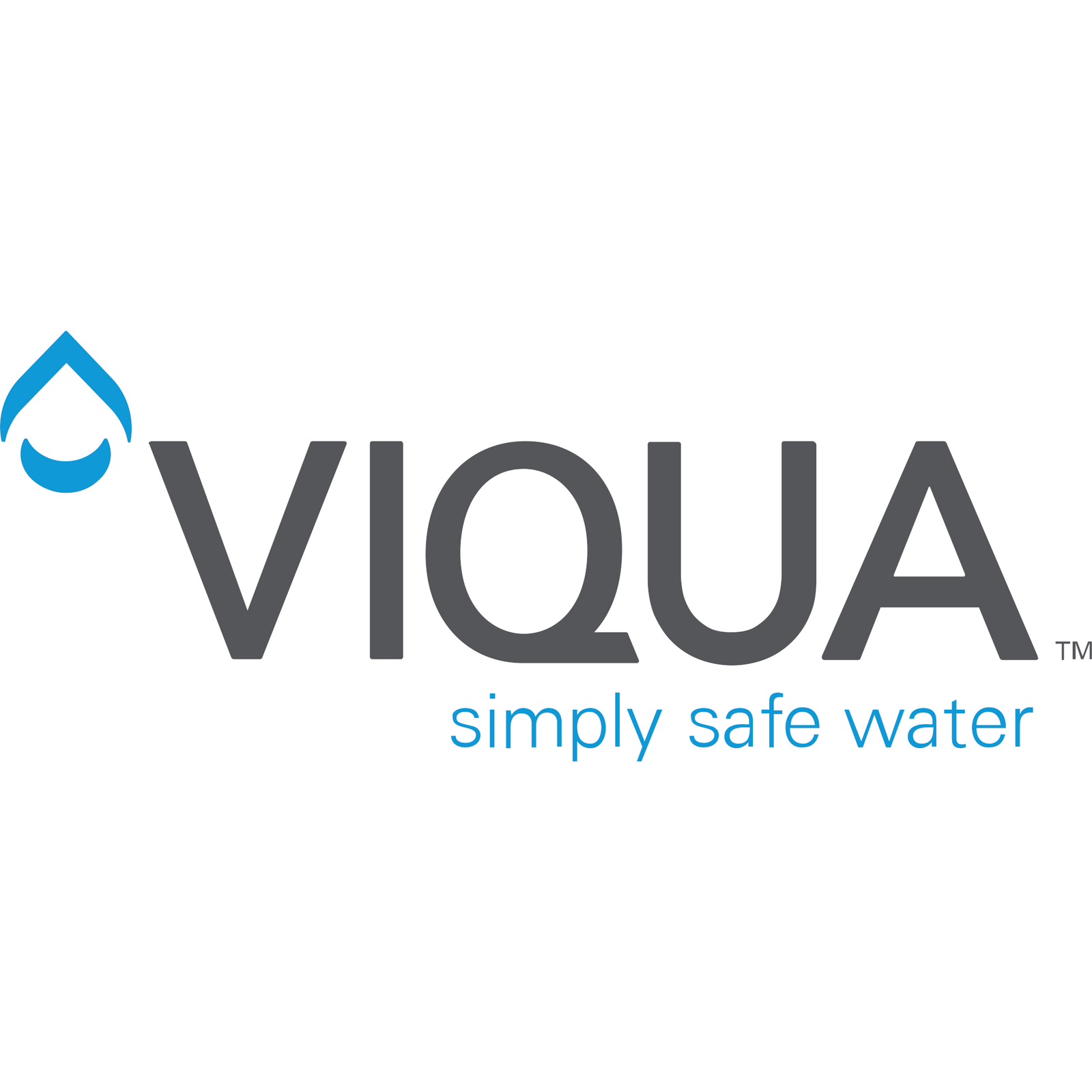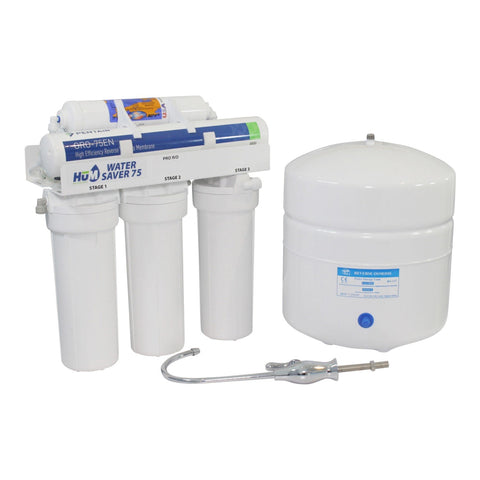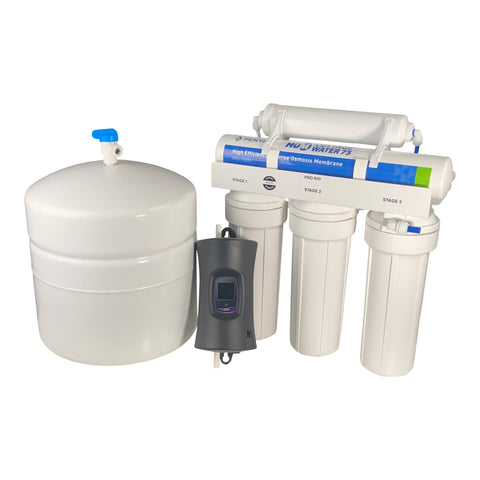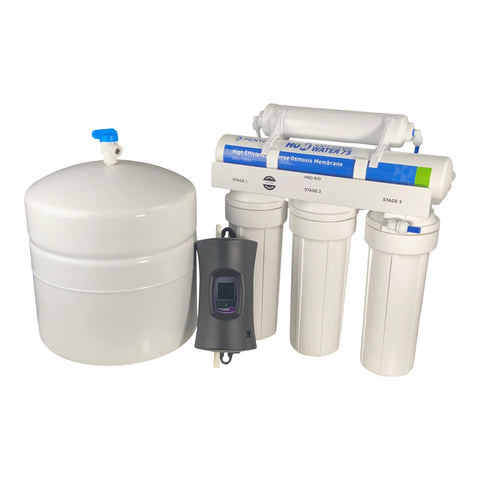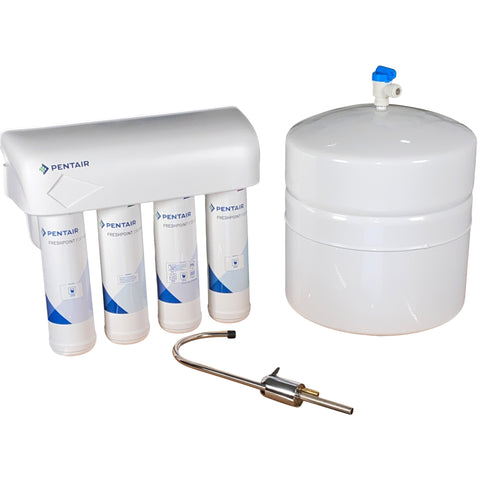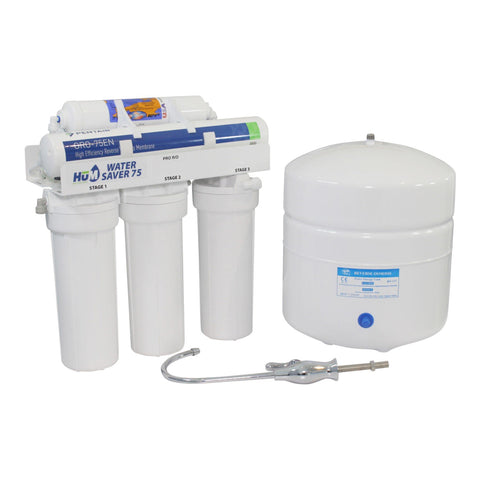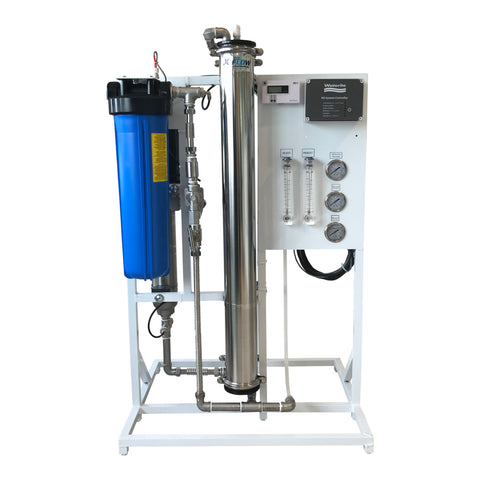Everything you wanted to know about Reverse Osmosis water and Reverse Osmosis Drinking Water Systems, but were afraid to ask!
On Saturday, April 4, 2020 I broadcasted the following Live Stream on Youtube. Check it out to learn more about what Reverse Osmosis water is, how we use RO systems to purify your water for your family and how to install and maintain!
Video Transcript
Gary The Water Guy:
I'd like to welcome everyone to my second live stream here on YouTube. Today's topic will be reverse osmosis Q&A. I'm Gary The Water Guy, and I simplify water filtration to help you conquer crappy water for your family. Again, today's topic is reverse osmosis Q&A. I'd like you to submit your questions on the ... I believe it's on the bottom right hand corner of your screen that you have about reverse osmosis, and I'll do my best to answer them during this hour. We're only on here for an hour today. But whatever questions you have, the answers will be in the comments down below, even if I don't get to them within the hour. The priority today will be on reverse osmosis.
Gary The Water Guy:
But if we don't have any questions, you're also welcome to pose any questions about any other aspect of water filtration or something else you may have seen in one of my videos that you just needed more information about. We're going to start with an introduction about what exactly reverse osmosis is, and how it works, et cetera. I am working on a 30 second time delay here. If you're wondering why I'm not answering your question as quickly as you think I might, then that's why. I'm going to go over some basics of reverse osmosis for the first little while, and then I'll get into your questions. I've also got some questions prepared ahead of time. I'd really like to thank everyone for their support.
Gary The Water Guy:
We're at over four million views right now, which equates into 10 million minutes watched on my YouTube channel, and I really appreciate everyone's support and thanks for checking it out. Especially those folks that have taken the time to subscribe to my channel, I really appreciate that. Okay, what else do we have here? We're going to be running a contest today, and the contest is to win this LED flashlight. What we're looking for are submissions. We're looking for video ideas for upcoming videos that I can make about any aspect of water filtration, and the deadline is tomorrow, April, the 5th at midnight. You can submit them to the comments down below. I'm going to take the best three submissions, I'm going to put them onto the community tab of our page.
Gary The Water Guy:
Where's the community tab? I'll show you where that is. Yeah, if you look at the top here, it shows you the community tab on there. If you go on there, that's where I'm going to put all the submissions, and then you can vote, and the person that gets the most votes is going to win that flashlight. But it's going to give ... Everyone's going to win because we're going to have three great topics to talk about. That's going to be great. This is my second live stream. The first one was water softener Q&A few weeks ago, and it didn't go so well. We had a lot of technical issues and that kind of thing. I think the content was pretty good. But the technical issues weren't that great. I've worked really hard to try to make sure we eliminate the technical issues from today. That's great.
Gary The Water Guy:
I see we're getting some more people on. That's great. I'm going to have to put my glasses on. Sorry about the glare from the glasses. [inaudible 00:03:15] 22 from Indiana, that's great. Thanks for tuning in today and joining us. Okay, what we're going to do, I'm just going to start off with a really basic explanation of what reverse osmosis is. I came across this little diagram, and I think it works really well. Where it says mains water in the top left, that's the raw water coming into the system. You can see that in the diagram, as it gets down lower, there's some water contaminants and then there's a semi permeable membrane at the bottom in the middle. That's what the water pressure is forcing the water through that membrane.
Gary The Water Guy:
The bad water or the high mineral content water goes to the drain, the good water or low mineral content water passes through that membrane, and then it comes out where it says pure water in the top right hand side. That's basically the process of reverse osmosis. Osmosis is when two different densities of water, if you'd like, equalize through a membrane. Reverse osmosis is when the external forces acted upon it. In this case, it's water pressure. That's the process for that. Let's take a question here to ask a quick question. This is from [Slatan 00:04:37], and his question is low motor pressure, how do we increase the pressure into the RO filter? There are booster pumps you can get.
Gary The Water Guy:
What I'll do is I'll put a link in the comment section down below of a booster pump that you can check out. You're right, but you do need good pressure to push that water through that membrane so that the reverse osmosis process can work. But those are definitely available. All right. Let's move on here. What's one reason why someone would consider reverse osmosis system in the first place? Well, the biggest thing that reverse osmosis does, it lowers the mineral content and that's what everyone hears about, everyone knows about, et cetera. But there's a lot of other benefits. More and more, you're going to be hearing about things like PPCPs, pharmaceuticals and personal care products being in the water.
Gary The Water Guy:
You're also going to hear about trihalomethanes, THMs. Trihalomethanes is when chlorine combines with organics in the water, and that's a concern. One of the great things reverse osmosis, in addition to lowering the mineral content of your water, it also removes PPCPs, and trihalomethanes. Folks often ask me, "Well, how in the world do pharmaceuticals and personal care products end up in the water?" Well, it all goes back to, I guess, in the '60s when they introduced birth control pills, and that the body can only absorb so much of the chemicals, and the rest of it, we excrete when we go to the washroom. Well, over the years, that ends up in the water supply. It's only a trace amount, but as the years, 10, 20, 30, 40, 50 years go by, that is in the water supply.
Gary The Water Guy:
One of the great things about reverse osmosis is that it removes those PPCPs from the water supply. Let's go back over here. All right. This is an image that I took actually many years ago. I did a video, I believe, four or five years ago. If you look at this, on the left hand side of your screen, you see a very, very dark filter. That's from reverse osmosis system here locally, local customer of mine. That's their first filter. I always tell everybody that brown stuff that you can see on my blue gloves, et cetera, that mud that's on there, that came out of the municipal water supply here in our local town. I always tell everybody, if this person didn't have a reverse osmosis system, where would have all that mud ended up? Well, it's pretty obvious where it ended up.
Gary The Water Guy:
The filter on the right hand side of the screen, the white one, is the last stage of the reverse osmosis drinking water system that we have in our store. What that means is that's the last filter in line. Everyone that's filling up their water jugs in our store, their last water is passing through that filter. As you can see, it's snow white. The filter on the left hand side of the screen started off looking exactly like that filter on the right hand side of the screen, a pure white. But now as you can see, it's totally covered with mud. Reverse osmosis does make a huge difference. Great. Mark Clark is with us today, and I see he's got a question. What's the best way to test for manganese? There are manganese test kits.
Gary The Water Guy:
Manganese typically stains black. Okay? If you have plastic PEX pipe that somewhat opaque, you can start to see black staining within it. That's caused by manganese. There are manganese test kits, et cetera. If you have a local lab, you can take the water in, have it tested for manganese. If all else fails, I always tell folks, you can always ship us a sample. I'll put our mailing address down below, and we can test it for you for manganese. We don't charge for water testing, and we can tell you what's going on there. There's a few ways that you can get rid of manganese from your water. Water softener actually does a pretty decent job of it, but there's some other filters too that are more specialized if your levels of manganese are higher. All right. Let's go on here.
Gary The Water Guy:
This one here, I find, is a really good chart for explaining how the whole reverse osmosis system process works. It's interesting because whether you've got a small 35 or 50 gallon per day reverse osmosis system in your home just for your drinking water, or whether you've got one of our big 9600 gallon per day systems for a car wash or something like that, the procedure is actually exactly the same. You can see here in this diagram I've got here, the contaminated feed water, or the raw water, if you like, enters the bottom right hand corner of the screen, it goes through the first stage, the second stage and the third stage. One common question I always have from people is why is the second and third stage the same filter? Why are they both carbon filter?
Gary The Water Guy:
It's about contact time. Typically, there wouldn't be enough contact time through just one filter, and that's why there's two. That's why it goes. That's why you'll see very low budget reverse osmosis system, might have one filter at the bottom or two filters at the bottom, and that's what you're giving up. That's the compromise. After it goes through those three filter housings at the bottom, then water goes up through the high pressure side of the automatic shutoff valve, then it goes through, see where it says fourth stage? In the middle four stage, the RO membranes. That's at the stage it actually goes through the reverse osmosis membrane. You can see the water heading off to the left there, and that's the water that's going to the drain, and then you can hear water going to the right and it goes, in this case, through another filter here.
Gary The Water Guy:
It must be alkaline filter or something like that. You can see it says a flow restrictor there. What happens is there needs to be a flow restrictor to back off that water flow as the water's going through there, and that backing off is what makes the reverse osmosis system work. Sometimes when people will say, "Oh, I've changed this, I've changed this [inaudible 00:10:48] in our system," often they forgot to put the flow restrictor back in and then they're surprised that it doesn't work after they've done that. All right, carrying on with this. Then it goes through this last filter, and then it goes again back through the automatic shutoff valve. Because what the automatic shutoff valve is compares the flow going in and the pressure going in and the pressure going out.
Gary The Water Guy:
Then from there, it determines when it starts to get the back pressure from the tank, then it shuts off. Then you can see it goes to the post carbon filter. This is what confuses a lot of people. It goes through the post carbon filter and then it hits to the tank and people say, "Well, I see there's one line going to the tank, but shouldn't there be one line going in and one line going out?" No, because it uses that same line. Then it goes through the carbon filter. You can see this a T on the left hand side in this illustration, goes back through the carbon filter, and then it goes out to your faucet. The reason it has this post carbon filter, this fifth stage, is because that's what gets rid of any taste or odor that the tank may have added to that.
Gary The Water Guy:
That's what that's all about. All right, we'll see. Okay, we've got ... [Daunior 00:12:03], I guess it is, 22 from Indiana's saying, "Got 25 parts per million reading good for our RO system filtered water, or does it have to be zero?" No, and that's actually one of the great benefits of reverse osmosis water, is it doesn't take it down to zero. It typically reduces the mineral content by about 95%, 90% to 95%, something like that. In this particular instance, they're probably starting off with water that somewhere around 250 to 300 parts per million, and it's reducing it down to 25 parts per million, and that's a great reading. It doesn't take it down to zero. Zero water is very flat. If you've ever drank distilled water, it's very, very flat, and most people don't care for the taste of it at all.
Gary The Water Guy:
That 25 parts per million, that's a good reading. Like I say, you must have a TDS meter, something like this one here, I suspect. That's a handy thing to have. We have a monitor, e-commerce store in our store here where you can test the water at any time and determine what the TDS is and how your system is doing. That's great. Contact information. The contact information is down below. We have for our websites, et cetera. When this video is finished, you'll see at the very bottom there's our contact information, our local website and our e-commerce website for both Canada and the US. Can I add another pre-filter? That's for Ahmed. Yeah, you can add another pre-filter. At some point, you have to question do you want four pre-filters?
Gary The Water Guy:
Because when we're talking pre-filters, it's really, I believe in an ideal world, three pre-filters before the membrane. To add another pre-filter, you've got the one sediment and you've got the two carbon, I think they work pretty well. When I change those filters after a year in a customer's home or in my own home, the first filter is brutally dirty, like that one I showed you earlier, that image. The next one is usually quite dirty too, and by the third pre-filter, it doesn't look that dirty anymore, but it's definitely doing its job. Adding another pre-filter might be overkill. Mark's got another question here. Without putting a softener, what would be the best pre-filter for a person that doesn't want to spend the money on a softer, but wants reverse osmosis in municipal water?
Gary The Water Guy:
Okay. A popular misconception, I think this industry has really bred that into people, is that you have to have a water softener before a reverse osmosis system. Absolutely not true. Okay? Your filters aren't going to last as long, your membrane isn't going to last as long with hard water. Okay? But it definitely can be done. We do that in doctors' offices, accountants' offices, places like that, where we put in a reverse osmosis system and we connect it up to a water cooler. Well, they don't have soft water in those scenarios. Yeah, the membrane on the reverse osmosis system, if they had soft water, would probably last four or five years. But because they have hard water, it doesn't. It may only last two or three years.
Gary The Water Guy:
But you can definitely still have reverse osmosis water, and you can have all the benefits. Definitely works. No problem at all. Ahmed is asking, "Can I add another large pre-sediment filter in the RO for extra pure water?" You can add it. But like I say, it's not going to really give you much of a payback at all. The membrane's what does all the work, and so adding another pre-filter doesn't make sense. Now, if you're on a cottage water application or well water or surface water from a lake or a stream or something like that, you should have some kind of pre-filtration on the whole cottage, okay? Then the reverse osmosis system. Again, dealing with the filters that come with a system, the five micron sediment filter and the two carbons is still definitely the way to go.
Gary The Water Guy:
[Fasulo 00:16:06], hi. He said hi. That's great. I appreciate comments like that. Great. For well water of 900, which RO system do you suggest? Again, I'll put a link down below so you can see exactly what I'm talking about. But the GoldLine 50 is a good choice for high TDS water. What I mean by high TDA water is anything above 500 parts per million. The GoldLine 50 is a great system. You can put a booster pump on it, and that'll give you really good performance at a really reasonable cost. It's a made in USA system. It has the three-eighth inch tubing that I'm going to talk about a little bit later, that every RO system should actually have so you get good flow. Yeah, that definitely would be a great suggestion for you.
Gary The Water Guy:
But like I say, I'll put a link in the comments down below once I finish the formal portion of this. We have a number of RO systems, both in our store and online, and people always say, "Well, which ones do you suggest in that?" In a lot of the videos, you'll see me featuring this system. It's a HUM Water Saver 75. HUM's our own private label brand. One of the things I really like about this, and keep this in mind when you're doing your shopping for a reverse osmosis system, the first points here that you see listed are the same. Reduces mineral content, removes lead, fluoride, nitrates and chemicals, produces reverse osmosis, eliminates waste and all that jazz. That's the same for every reverse osmosis system. Where it really gets interesting is the high flow three-eight inch tubing.
Gary The Water Guy:
That's a necessity, that's a must. If you don't have that three-eight inch tubing, the difference in flow is phenomenal. I have a reverse osmosis video being released probably in the next couple of weeks that actually compares a reverse osmosis system with quarter inch tubing versus three-eighth inch tubing, and the difference in the water flowing out of the faucet, it comes out half as fast. Everybody's going to have to wait twice as long to fill up that coffee carafe or to fill up their water glass et cetera. That's a huge thing. Made in USA. We've tried the Chinese and the Korean reverse osmosis systems, and we've had problems with them. Believe me, when we deal with water, we don't want to have problems. We don't want to have any leaks or anything like that going on.
Gary The Water Guy:
We've stuck with the made in USA products for, geez, I guess about eight years now, and we've had fantastic performance and super reliable. That's really important. A high efficiency reverse osmosis system like this one here, half the wasted water. I did a video a little while ago comparing a couple reverse osmosis systems and this Water Saver 75. Actually there's less than half the water that goes through the drain as what does with a typical reverse osmosis system, and that's huge. When you multiply it by a day, a week, a month, a year, 15-year life expectancy, it's amazing the difference that makes, and that's a very important feature when you're thinking about investing in a reverse osmosis system. When we get to reverse osmosis in terms of home type systems, there's some options that I think you should at least be aware of.
Gary The Water Guy:
Whether you decide to invest them or not, that's up to you. But one thing that I really like and has come into the play a lot more common in the last five or 10 years is this guards leak stop. Basically, what it is it's a system that water flows through this, and if it detects a leak, then it shuts the whole system off. When you're putting a reverse osmosis system into a finished area. I don't know if you can see that or not. Focus picking up. I guess it's pretty bright. Okay? This is what it looks like. Basically how it works is that ... I'll hold it up here, maybe you can see it a little bit better. All right. Basically what happens is water flows into the system. Yes, this way. Water flows into the system here and then flows back out through here.
Gary The Water Guy:
If there's a spill or if there's any water in here, even just a couple of drops, there's a pill at the bottom here. I don't know if you can see that or not. There's a pill, and what it does it expands relatively quickly. You'd be surprised. It has a plunger inside here that pushes up and shuts off all the water. If you get a leak in that area, then it shuts it off. If you're putting a reverse osmosis system under the kitchen sink, and it's a finished area, that's a great feature to put in. We always install those and it makes sure that it shuts off any water and wouldn't cause any damage, if there was ever a leak. Now, the leak can be for anything. If someone puts a watering can down there for plants and spill some water or your faucet at your kitchen sink leaks, it's also going to shut that off.
Gary The Water Guy:
That's an important feature. All right, we got some more questions here, and let's see what we got here. What do you think about the all in one Brondell H2O+ system? Sorry, it's not one I'm familiar with. Once this video is done, I'll do a Google search for it and see. There's hundreds of brands out there of reverse osmosis drinking water systems, and I haven't evaluated every one of them. That's not part of what we do here. I'm sorry, I haven't come across that one. That was from Keith, by the way. Any additional cartridge is used for well water due to hardness? I have seen some reverse osmosis systems that have a water softening cartridge in there. The only problem is because there's no way of regenerating that cartridge, it doesn't last very long at all. Basically, it's useless.
Gary The Water Guy:
On well water, I guess ... [Facellu 00:21:51] is asking this question because I guess they don't have a water softener. I wouldn't worry about it. Just put the reverse osmosis system in, you're going to have more filter maintenance, you're going to have to change the filters more often. But it'll definitely do the job whether you're on well water or not. Now, if you're on well water, you need to make sure that water is disinfected. If you don't have a whole house ultraviolet disinfection system, then you need to add one. I got a picture of one here. Yeah, this one here. This is a small one gallon per minute reverse osmosis UV system. It's the same reverse osmosis system, it's just as the water is heading up to the faucet, you would just install a small ultraviolet disinfection unit so that as the water passes through, it kills any bacteria in there.
Gary The Water Guy:
The lamp in there only last 12 months of use, so you definitely have to replace that lamp after 12 months of use. But that's a great way of having bacteria free water with your reverse osmosis system and if you choose not to put a whole house ultraviolet disinfection system. I live on well water. We have a whole house ultraviolet disinfection system and then we have reverse osmosis for just the one faucet at the kitchen sink, and of course connected up to the fridge. Ahmed, here's [inaudible 00:23:11] What will happen if I remove the high pressure switch? Don't know. Never tried it. Give it a shot, let me know how it turns out. Mark Clark's asking, "If I wanted to collect all of your videos because I just found you, what would I do?" You just go to my YouTube channel, Garythewaterguy.com.
Gary The Water Guy:
There's 250 videos on there. In the top right, you can sort them by date, I guess oldest to the newest or newest to oldest or whatever, and you can watch them. You'll see a huge difference between the ones I did in 2012 when I had brown hair, compared to the ones I'm doing in 2021, I have gray hair, but they've evolved a lot. All my YouTube videos now are all in 4K, so you see a lot higher quality. I've got better sound and better lighting, et cetera. They've definitely evolved. I have a submersed well pump that comes into ... Have you ever visited a distributor such as Clack? No, I haven't. I've gone to the convention. The water treatment convention this year was canceled. It was about a week or two weeks ago, for obvious reasons. But I do go to the conventions at least every second year, if not every year, and Clack always has a huge booth there.
Gary The Water Guy:
Clack's an amazing company that makes some amazing products. All of our HUM water care, water softeners, iron filters, et cetera, all use Clack valves. I really like the product. It's a real game changer. What's really interesting is the current Clack valve, the current WS1, has been around since the year 2000. You think, "Oh wow, the thing's 20 years old." Yeah, it's 20 years old, but it's the most contemporary water treatment valve out there that I know of and then I've got experience with that works extremely well. Okay. Okay, let me continue on with some more information then I'll get back to answering some more questions. Something else, some people ask me all the time, "Well, doesn't reverse osmosis take out too many minerals, too many that ... I'd like to have my pH a little bit higher, or I'd like to have a little bit more minerals in my water," or something like that.
Gary The Water Guy:
Then in a situation like that, you can add a remineralization kit. That's what I have here on the screen. We offer that, obviously through our e-commerce store, et cetera. Basically, it's just another filter, and that filter has calcium mineral or calcite. As the water goes through the whole reverse osmosis process, then it adds a small amount of calcium back into the water to, like I say, increase the pH a little bit, and also to ... Neutralize the pH, I should say, and also to add some calcium back into the water. All right, what else do we got here? For a buyer's guide, one of the priorities of today's Q&A was obviously to answer your questions, et cetera, but also to give you some buying guide information.
Gary The Water Guy:
One of the things that's always super important is proprietary filters and membranes. That's always super important. You'd be amazed at how many people have invested in a proprietary brand, not going to mention who they are, but proprietary brand, and then when it comes time to replace their membrane, they find out the membrane's $250, and they find out the filters are $50 or $60 each for the reverse osmosis system. Whereas if you go with a non-proprietary reverse osmosis system, like most of the ones that we handle, for example, the four filters are like 60 bucks, the membrane's like $75 or $80. Worst case scenario, usually around $100. Non-proprietary's super important. Made in USA, I absolutely believe that because no one makes any in Canada. But in the USA, reverse osmosis systems are giving amazing value for the money and they just keep on working.
Gary The Water Guy:
15 years lifespan out of them, no problem at all. Three-eighth inch tubing from the tank to the faucet because of that flow. A large 14 ounce glass, which I don't have here right now, actually it's about the size, 14 ounce glass, with a three-eighth inch tubing, reverse osmosis system takes six, seven seconds to fill. With a quarter inch tubing, reverse osmosis system before, 13, 14 seconds, something like that. I've got a video coming up about that in a few few weeks. High efficiency reverse osmosis, so you've got less wasted water. I think that's very important. How many stages it has, I think that's super important. Five-stage reverse osmosis is the sweet spot. The ones with two or three stages, don't even bother. They're just going to give you grief. The ones that have eight, nine and 10 stages, they're just a money grab.
Gary The Water Guy:
They're putting extra stages on there because now they're thinking that adds more value. But you know what? It really doesn't. Try to avoid those. All right, we got some more questions here. Let's see, where did I leave off? Bali [Garane 00:28:19] Sorry for pronouncing names wrong. "I have a submersible pump. It comes into pump house, there is no filter before the pressure vessel and water softener. Should I fit one? Thank you." No. We don't like to put filters before the pressure tank, and I'll explain to you why, and that is, at the pressure tank, there's a pressure switch, right? What happens is, let's say you run 40 to 60 psi. The water pressure drops down to 40 psi, the pump clicks in, pumps the pressure back up to 60 psi, the pump clicks off.
Gary The Water Guy:
The problem is if you put something on before that pressure tank, a filter and that filter becomes clogged, what's going to happen is that it's going to be telling the pump, "Hey, I need more pressure. Turn on." It turns the pump on, but the pressure never hits 60 psi because the lines clogged, and then it'll burn out your pump. With submersible pump, they're super expensive. It's not something that you want to do. No, I don't suggest you to do that. All filtration goes on after the pressure tank. A few very small exceptions we're not going to talk about today. But in terms of what we're asked here, no, it would go after the pressure tank. What's the recommended range of RO system product TDS? Product TDS. Well, we have to keep it under 500 parts per million, because 500 parts per million TDS is the drinking water standard.
Gary The Water Guy:
We always want to make sure we get it under 500 parts per million. Generally speaking, the lower the better. The ideal sweet spot, if you like, would be somewhere around 25 to 50 TDS. In a perfect world, that's where we'd like to end up. But the problem is some folks are starting off With a TDS of 3,000 parts per million. Well, that's super high. Okay, 3,000 parts per million, you're not going to get it down to 25, or it'd be super rare if you did so. It really depends on that. Other folks might be starting with 80 or 90 TDS, especially people that are on surface water, lake water, et cetera. Like I said, that would be quite low. Oh, great. [Ramen 00:30:30] has just cleared up the [inaudible 00:30:35] Ramen. Great. Thank you.
Gary The Water Guy:
All right, let's move on here. Give you some more information. Installation guide, okay. When you're thinking about installing a reverse osmosis system, there's two locations. One is right underneath the kitchen sink, and I'd say that's the second best location. The best location is if you have an unfinished area underneath where your kitchen is, or adjacent to it, or something like that, you can put it in there. In my house, for example, the basement underneath my kitchen is unfinished. The reverse osmosis system lives down there, and then we just have three-eight inch tubing that goes up to the faucet. Now, you can't run that tubing too far. Usually 20 feet is about the maximum. After that, you start to significantly slow down the flow.
Gary The Water Guy:
You don't want to make it more than 20 feet. Luckily, with a three-eighth inch tubing, you've got good flow there to begin with, so it doesn't compromise it all that much. For location, that would be the best location, but underneath the sink works perfectly well. If you're connecting a reverse osmosis system to the fridge, you need a T that looks just like this. Does that focus pick it up? Yeah, great. You can see you've got the three-eighth inch tubing that goes in and out, and then you've got the quarter inch connection here, which would go to the fridge. Again, always think about that in your installation. Even if you don't have a fridge right now with an ice or water dispenser, sometime in the future, you might. If you do, if you're running that tubing, it's always best to run plastic tubing to the fridge instead of copper.
Gary The Water Guy:
Okay? When you're doing an installation, leave extra tubing on the system, because think about when you're going to do the filter change in the future. You're going to want to, if it's under the sink, for example, open up the coverage, you want to grab the reverse osmosis system, pull it out, and then put a bucket underneath or something like that so you can do the maintenance, so you can disconnected the filter housing susceptor, open them up. Then once you've done the maintenance, you can slide it back in. Okay? Keep that in mind. Make sure you allow for that extra tubing. It will make your life far easier in the future. We talked about the leak stop, very important if you're putting in a finished area.
Gary The Water Guy:
Now, if it's going in an unfinished area, like a basement that's damp or something like that, don't put in the leak stop. Because that little tablet, that little tablet inside here, will absorb water, okay? If it's a humid area in the basement in older farmhouse or something like that, some water on the floor, that humidity will get absorbed in this little tablet, and it'll expand and it'll shut off your water. When people phone me, we've installed a reverse osmosis system with a leak stop and that kind of thing, and they'll say, "I don't know. All of a sudden, the flow slowed down and I've got no water." I always ask them, "Pick up the tank, is it light?" "Yep, it's light." "It's probably the leak stop. If it's heavy, it's something else." All right. You can always improve the flow of a reverse osmosis system by adding a second tank.
Gary The Water Guy:
We did an experiment with that. Actually, my house has that, now that I think about it. We have one tank in the basement, and then to improve the flow and to improve the amount of reverse osmosis water, I have another tank that I installed right underneath the faucet at the kitchen sink, and that gives me high flow for twice as long. That's something to consider. We also have the great big 14 gallon tanks and for large families. We've got one situation where we've put reverse osmosis in a kettle. A kennel, sorry. We put two of these great big 14 gallon tanks in there. In the morning, they get up, they fill up all the water dishes for the dogs, and then during the day, it fills up again, they fill up the water dishes, and then all night again, fills up the tank again.
Gary The Water Guy:
Again, that's only with a GoldLine 50 reverse osmosis system. It's only a 50 gallons per day system, and they fill these two big 14 gallon tanks. It's cool. Great. We have some more questions coming in here. What do we got here? Oh, okay. It's just a thank you for the answer. Great. Moving on. Now we're talking a little bit more about maintenance. Common question is how often should I change my filters? I just got a call today from someone that said, "Oh, I got to get in here and change out my reverse osmosis filters." I says, "Why?" They said, "Well, because the manual says I have to change it every three months." No, they just want to sell you filters. That's what it is. If you base it on a family of three or four, something like that, typically once a year you would have to change the filters.
Gary The Water Guy:
There are some exceptions. Of course, if you have a larger family, then you're going to have change them every six months or something like that. If you have a small family, one person, one gentleman or lady living by themselves and that kind of thing, you can go 18 months. But generally speaking, I recommend once a year. Once a year seems to work for everyone. The membrane, again, depending on whether you have hard water or soft water, can get anywhere from three to five years. I've seen some last seven or eight years. But how do you know when it's time to change the membrane? You use your TDS meter. Does that focus? Yeah. Once that TDS, the ratio between the raw water ... Oh sorry, the water coming out of the faucet and the water ... Sorry, the household faucet and the water coming out of the reverse osmosis faucet, you compare the two.
Gary The Water Guy:
Once the difference is less than 75% difference, then it's definitely time to change that membrane. Another maintenance, you know the O ring at the top? I don't have one here. Actual here. You know the O rings that are at the top here? What I suggest is, when you unscrew that, to use plumbers clear silicone grease on those O rings. It's going to do two things. One is it's going to make that O ring last longer because the rubber will absorb the silicone, and so it'll keep those O rings lasting longer, but also will keep the O rings from stretching. I guess there's a third benefit too, is you don't need to tighten them quite so tight for them to seal up the water, and obviously it makes it easier when it comes time to change the filters again in the future.
Gary The Water Guy:
Where do you get the silicone grease? We have it on our website. I'll put a link down below. When you're doing the reverse osmosis maintenance, you got the unit out, you shut off the water, you've drained the water, you're getting ready to change the filters, you've unscrewed the old filters. Before you put the new filters in, before you unpack those new filters, wash your hands with soap and water. Hot soapy water. 20 second rule, we're talking about these days, and then handle those filters and put them in. When you initially install a reverse osmosis system or you replace the membrane and you turn the water back on and you've got nothing coming out of the faucet, that's because it takes time. It takes about two to three hours for water to build up inside that tank for you to get great flow again.
Gary The Water Guy:
Don't be disappointed you set it all up and you've got this little trickle of water, and you're wondering what went wrong. Well, it takes time. It takes time to build back up. The other thing is if you replace the filters, you got to flush them at least one tankful, ideally two. If you replace the membrane, you've got to flush the membrane with three to four tank full of water. Yep, you're going to have to fill the tank, flush that membrane, another two or three hours to fill the tank. You're going to have to do that several times to flush it. All right, great. Okay, troubleshooting guide. The most common question and I've got a video that little or no flow from your reverse osmosis system. I think that's one of my third or fourth most popular videos that I've ever made, and that's a common concern.
Gary The Water Guy:
You've had to reverse osmosis system for anywhere from three to five years or something like that, and then all of a sudden, you go to get a glass of water, the water comes out great, comes out fast for maybe five or 10 seconds, and then it slows right down to a trickle. Then you wait another 20 minutes or so, and it's the same thing again. You go to lift up the tank and the tank's heavy. What's happened is the tank has lost its pre-charge. I have a great ... Well, I can see that video that I just mentioned as a procedure. That's how you go about doing that. But when you do that, you got to do it exactly like I say, and that is you need to make sure the tank is totally empty.
Gary The Water Guy:
How you empty it, because the water may not come out by itself when you ... You disconnect the tank and then you take it outside and you open up the shut off and water should flow out. If it doesn't, then you got to push that water out. How do you do that? You take a compressor or whatever you're going to use to recharge the tank, the air, and you attach it to it with a valve open and water will blow out. Now, you don't want to put too much air in there because you'll actually burst the diaphragm inside. You put in, hold it on for two or three seconds, let the water go out. As it dies down, hold it on in that. Anyway, once you're done, you recharge the tank to about seven psi, and then you're good to go.
Gary The Water Guy:
If you open up the cap where the air goes and water leaks out, the tank's done. Don't even bother. Just put in a new tank. We've replaced some tanks and you can do that. The next most common complaint or concern I have in troubleshooting reverse osmosis is that no water comes out. Absolutely no water. Assuming it's not the leak stop, because that's the first thing we check these days, it's leak stop that's been triggered. Assuming it's not the leak stop, then you go through when was the membrane change, when were the filters changed, et cetera. Because those things, if the membrane's clogged or the filters are clogged, you're not getting any water out of the system.
Gary The Water Guy:
Make sure you check that. Then the other thing we do, is it open? Is it turned on? Is it shut off? Often when people do the filter change, that's when concern like that surfaces, so you have to go back and check the steps of what you did, and that's where that comes into play. I got an off-the-topic question here, which is no problem at all because we're not backed up on questions at the moment. Is it necessary to put a sediment and carbon filter before softener? No. In fact, a carbon ... I guess, one of those answers, it depends. If you're on a municipal water system that has chlorine in it, then it's a good idea to put a carbon filter before the water softener. The reason is that chlorine is very hard on the resin beads.
Gary The Water Guy:
It can actually break down the beads and it can actually clog the water softener by those beads breaking down. In a municipal system, it's a good idea to put in a carbon filter beforehand. Sediment filter, probably not. Now, if you're on well water ... I have some customers that are in a very sandy area and has series of cottages in that area. There you have a lot of sand in the water. Every one of those properties has a big 20 inch Big Blue sediment filter. We go up there once a year to change the filters, those sediment filters. Those filter housings are so jammed with sand sometimes we actually have trouble pulling the filter out of the filter housing because it's totally socked in, they're totally jammed. In those scenarios, absolutely.
Gary The Water Guy:
You have to weigh things back and forth a little bit. It depends on the circumstances, I guess. My house, for example, I don't ... Like I said, we're on well water. I don't have any kind of filtration before the pressure tank, iron filter, water softener, and then after that, I've got a three-stage ultraviolet disinfection system. That's where I have my carbon filter and my sediment filter, and of course, the UV. Like I said, it depends on the situation. Even if the tank is full, RO pump starts and stops again and every one to two seconds. What would cause that? RO pump [inaudible 00:42:33] I would check the pressure switch that turns the RO on and off. It detects flow. Is it possible you got a slow leak in there or something or in the faucet or something like that? Is the faucet leaking? Those things would all cause that pump to turn on and off.
Gary The Water Guy:
Other than that, I'm lost at what else might be causing that. It is a pressure switch, and that's what determines it. It's either a faulty pressure switch or you got a leak in the system somewhere. One question I ask often is what's the difference between big box reverse osmosis system and the kind of reverse osmosis systems that we sell? There's a lot of differences. In fact, I've got a video coming up actually doing comparison between a big box reverse osmosis system and the HUM Water Saver 75. There's a lot of things that you need to consider there. Like I said, the build quality is number one, the proprietary filters. A lot of those big box store ones have their own proprietary filters. As long as those filters are available, they can charge you whatever they want because they're the only game in town.
Gary The Water Guy:
It's the only place you can get them. Once they decide to discontinue those proprietary filters, might as well just throw away the reverse osmosis system. Water Saver 75, like the one that we have here, the GoldLine 50, those ones, they all use non-proprietary filters. In other words, the filters fit that system, but also fit 20, 30, 40, 50 other systems, so they'll never become obsolete because everybody needs them for all those systems. That's why non-proprietary filters are so important. The build quality, like I say, that's another big difference with the made in USA ones compared to the big box ones. And of course, the three-eighth inch tubing. Some of those things we've talked about already are some of the differences.
Gary The Water Guy:
Another question I'm asked from time to time is municipal water source. [inaudible 00:44:28] on municipal water, I don't need reverse osmosis, right? I don't know. It depends. I've seen municipal water sources, like Toronto, for example, the TDS is around 60, 65 parts per million. Reverse osmosis is only going to take it down to about five or eight TDS or something like that. But, remember reverse osmosis can do a lot more. It's going to get rid of those PPCPs, those trihalomethanes, THMs, et cetera. Also, going to get rid of the fluoride from the water, it's going to get rid of any sodium in the water, that kind of thing. There's still benefits there. I've seen municipal water systems that are five and 600 parts per million. Well, definitely need to reverse osmosis system there.
Gary The Water Guy:
How long does a reverse osmosis drinking water system last? Again, it depends. If you get one of those big box store ones, I've seen them last three to five years. I have one here that I'm doing a comparison with to the HUM Water Saver 75 in an upcoming video. I believe it even says right in the manual it's only going to last four to five years. Well, the HUM Water Saver 75 or GoldLine 50 in that, 15 to 20 years, no problem. You get what you pay for to some degree, right? What's the best place to get replacement filters for a reverse osmosis system? Again, that comes down to if it's a proprietary system or a non-proprietary system. We don't sell any of the proprietary filters because we can't get them. We're not a dealer for some of those brands out there. You have to go back to wherever you bought that reverse osmosis system.
Gary The Water Guy:
You'd be amazed at how many people that bought that proprietary reverse osmosis system, that when it comes time to replacing their membrane and their filters, the total bill ends up being to four to $500. While a lot of cases, you can replace it with a non-proprietary reverse osmosis system, like I said, the HUM Water Care 75 or the GoldLine 50, and pay that money toward that. Then going forward, your filter replacement cost is going to be super low. We have a number of customers that have actually chosen to do that. Like I said, it's a good investment for your family. What else do I have here? Here's a good one. If I have a UV system on my well water, do I still need an RO? Let's think about that for a second. Surface water is very low in mineral content. Okay?
Gary The Water Guy:
That's what reverse osmosis water is, right? If you have a UV to kill the bacteria in your water, great. You got low mineral content, it's bacteria free, you've got no chlorine in it because you're not putting it. The municipality isn't affecting your water in that. Are you done? Well, it depends. Again, often if you got surface water, you've got some tannins in the water, reverse osmosis will get rid of that, and then all the other concerns you could potentially have. A lot of folks on well water or surface water put in the UV to make sure the waters bacteria free for the whole house, and then put in a reverse osmosis system just for their drinking water to make sure that they've got super high quality water, but it also gives a second barrier from that bacteria.
Gary The Water Guy:
Because reverse osmosis will shun bacteria, but eventually, it'll get through. But it does give you that second barrier. Again, that's what I have in my house. A whole house UV and reverse osmosis for the drinking water. Okay. What are the basic differences between iron filter and softener? Basic differences between iron filter and water softener. A water softer will remove some iron. An iron filter won't soften the water at all. It really depends, and always comes down to water test results. I get messages from people all the time, and they say, "Hey, Gary. I need a whole house system. What do you suggest?" I always have to back up a little bit and say, "Okay, in addition to knowing how much water you use, so how many people live there, in addition to knowing, are you noticing any staining and things like that?"
Gary The Water Guy:
I really need to have a water analysis. A lot of folks email us water analysis, we put together system for them, and then we ship it out to them wherever they are. But if I don't know what's in your water and if you're not getting me some symptoms, I'm just guessing and I won't tell you. Unfortunately, there's some people out there that will tell you, but of course they're just guessing. You really need to know. If you have iron in your water above 1.0 parts per million, generally, you need a standalone iron filter to get rid of that. If your iron content is less than one part per million and you have hard water and you want to just get by with one piece of equipment, you can do it with a water softener.
Gary The Water Guy:
The only problem is the settings for the water softer will have to be more aggressive so you can use more salt, and some folks don't want to do that. In that scenario, you have an iron filter and a water softener. The water softener does two things, like I say, softens water and removes iron. The iron filter also does two things, and that is it removes iron and it also gets rid of sulfur, if you have sulfur smell in the water. Now depending on how much sulfur you have and how much iron you have, it influences which iron filter you need. But generally, that's the thing. Yes, Robin, I answered your question about water softener reduce iron. Yep. Can I hook up a second faucet to my RO? Yeah, you can.
Gary The Water Guy:
We've actually done some installations in recent years where we've one property in particular. They put in two reverse osmosis faucets, one was in the kitchen sink, obviously, the other one was in the master en suite. Then we also ran another line to a chiller. They were using that for cold water. I can't remember. It was in the bar, I think. Then we actually put in a delivery pump. What it would do, it'd fill the tank. I think we put in a big 14 gallon tank in that installation. We put the delivery pump on the wall. What happens is, as the water starts to flow, the pressure starts to slow down, so the water would normally slow down. But this delivery pump picks that up, and it maintains the pressure and actually pushes the water out of the tank through the pipes to the faucets, and that was tedious installation.
Gary The Water Guy:
Obviously, there was some costs involved. But yeah, you can definitely put it in a second faucet. Now, the longer the run of tubing that goes to that faucet, the more likely that your flow is going to slow down. Keep that in mind. But yeah, it can be done, no problem. Great. Let's just have a quick look at ... One thing I'd like to talk about today is about some of the haters, the reverse osmosis haters. People often make comments to me about ... Most people are great. They're just looking for information, I give them information, and people say to me, "Well, I've heard that reverse osmosis takes all the good stuff out of the water." I always tell the same story to everyone, and this is it, is that I believe that mankind was put on this earth to drink surface water.
Gary The Water Guy:
I don't really believe we were meant to go out there, dig a hole two or 300 feet into the ground, suck that water out, and that's the water we're going to drink when we got all the surface water. Other than the pollution that exists in the surface water now, and of course, the beaver's fever and all that kind of stuff, if you look at the specifications of surface water and compare it to well water or municipal water, or compared to those things, you'll see that the specifications of reverse osmosis and surface water are very close. The pH of surface water, it's usually about six to 6.2. Reverse osmosis six to 6.2. The mineral content, very, very low, usually 50 parts per million or less. Same with reverse osmosis water.
Gary The Water Guy:
The hardness is pretty much zero. Iron content is pretty much zero. That's why I believe very much on reverse osmosis water. People talk about alkaline water, they talk about all this other stuff, and Fiji Water and spring water and all this other kind of stuff. I really get back to the basics, get back to we were put on this planet or evolved or whatever you believe in, I don't believe to, like I said, drill that hole and suck that water. I believe we're meant to doing surface water and reverse osmosis gives you the closest to surface water, but removing all that stuff that's been added over the years. We still got seven minutes left. I still got some more stuff to go on.
Gary The Water Guy:
If you have any more questions, please feel free to submit them. I really look forward to answering your questions today. If you think of something after, add it to the comments down below. I do read every single comment that anyone puts on any of my videos. I try to respond to most of them, and I add them there. Someone asked here, "How do I know when it's time to replace the membrane?" That comes back again to the TDS meter. TDS meter, you test the water and you see the TDS is climbing, or like I say, the difference is less than 70%, then it's time to replace that. What else we got here? People asking questions here, what's the difference? 75 gallons per day, 50 gallons per day reverse osmosis, what's the difference? Well, it's how quickly it makes the water.
Gary The Water Guy:
Now, one thing I need to caution you on, the colder the water, the denser it is. Up here in Midland, Ontario, 100 miles north of Toronto, our water's a lot colder than it is in California. Because of that, that GoldLine 50 that'll give you 50 gallons per day, in California will only give you about 28 gallons per day here because the water is so much colder. If it produces 75 gallons per day, it produces water 50% faster than a reverse osmosis system that produces 50 gallons per day. That's really the difference in those ratings. Winter storage for reverse osmosis system. Again, we're up here in Cottage Country, north of Toronto, and often people say to me, "Well, I drained my cottage in the wintertime, and everything freezes in here. What do I do with my reverse cosmoses system?"
Gary The Water Guy:
You disconnect it, put it in the trunk of your car, take it home and leave it in your basement where it's warm over the wintertime. In the spring, you come back and reconnect it. That's the best way. Once you've reconnected it, make sure you flush the filters a couple times, and you're good to go. What else have I got here for you folks today? Reverse osmosis filters, are the universal? Most of reverse osmosis systems, the bottom three filters, these ones here, they are universal. Okay? You've got the stage one is the sediment and then the two carbon. The one that isn't universal is the one in the top here. People often say to me, "Well, which one do I have? How do I know?" You look at the end of the filter housings. I don't know if you can see. I think you can see it there. Okay?
Gary The Water Guy:
This one here has a fitting. You have to unscrew that fitting and take it from your old filter and add it to your new filter. Okay? This one here is a quick connect fitting, so you just pull it out. What's critical when you're contacting us or when you're trying to decide which is the right system for you, look at this post filter on the top because that will tell you which one it is. A couple more questions here from [Semos 00:56:17]. "Does the RO tank add water pressure to your line?" Does it add water pressure? Yes, it does. Well, it repressurizes the water coming from reverse osmosis system. Yes. Okay? Your reverse osmosis system makes water, it goes into that RO tank, which of course is a bladder tank, and it repressurizes it. That's why when the water first starts coming under your reverse osmosis tank, the water's of higher pressure and higher flow.
Gary The Water Guy:
Then as the tank gets half empty or it starts to get less empty, then you can see the flow starts to slow down. I hope that answers your question. Would it be an issue to put larger gallon per day membrane than you actually need? Well, I'll give you an example. I have a picture here, I think, of ... Yes, this one here. Okay. This is a whole house reverse osmosis system, and this is actually the one that we have in our store here. The one we have in store is 1,400 gallons per day. See that stainless steel cylinder that's up and down in the middle? That's 2,400 gallon per day membrane. A 4,800 gallon per day has to have those membranes, or 96 has four of those membranes.
Gary The Water Guy:
That's how you increase the production, is by adding more membranes. I hope that answers your question. If your question was, can you remove a 50 gallon per day membrane and substitute a 100 gallon per day membrane to get twice as much flow, the answer is no. Because there's other things in the system, the flow restrictors and a few other things that have to be compatible with that 100 gallon per day membrane as opposed to the 50 gallon per day membrane. I'd like to remind everybody don't forget about the contest. I really like to see some submissions or some ideas from you. We're at over 250 videos right now. I post a new video every 5:00 AM, every Saturday morning. Sorry, every Saturday morning at 5:00 AM I post a new video every week.
Gary The Water Guy:
I'd love to get some video ideas from you and see what we should be doing in the future, and also help you ... The contest, and the person that wins the contest will win this flashlight. Like I say, I'm going to take three submissions, the best three submissions. I'm going to put it on to the community tab of our channel, and you can go there and vote. The person that gets the most votes wins. Is there any ratio between RO booster pump pressure rating, membrane capacity and drain restrictor? There used to be, but remember the pump is just pushing the water through. No, there really isn't. It's more or less compensating for, A, either super high TDS, or B, low water pressure that you have.
Gary The Water Guy:
As far as I know, I don't think there really is any rating with that unless you're looking at three or 4,000 TDS. But then that would be a whole other situation. All right. We've only got about a minute left, so I'm just going to get ready here to sign off. I really appreciate everyone that watched today. I do. If you haven't subscribed, I'd appreciate if you subscribe to our channel, that way you'll be notified more about the stuff that's going on. Like I say, every Saturday morning 5:00 AM, we have a new video coming out. I have about 10 or 12 already set for the next little while, and we'll see more.
Gary The Water Guy:
If you like this live stream thing, please let me know. I'm on the fence now deciding whether we're going to do these in the future or not. If you think you'd like to see another one, I'm thinking about doing one about water testing, I'm thinking about doing one about ultraviolet disinfection, I'm thinking about whatever you're thinking about. Give it some thought.
Again, I'm Gary The Water Guy. I simplify water filtration to help you conquer crappy water for your family, and we'll see you next time. Thanks for watching.


